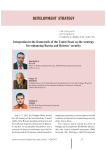Economic and Social Changes: Facts, Trends, Forecast @volnc-esc-en
Статьи журнала - Economic and Social Changes: Facts, Trends, Forecast
Все статьи: 1728
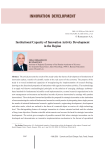
Institutional capacity of innovation activity development in the region
Статья научная
The article presents the results of the study under the theme of development of institutions of innovation sphere, transfer of scientific results to the real sector of the economy. The purpose of the study is to reveal institutional capacities of strengthening the implementation of research findings, drawing on the functional properties of institutions with regard to innovation activities. The methodology is to apply well-known methodological principles to the solution of emerging challenges (software-based method for fundamental scientific result implementation, sectoral research organizations in the new management environment and statistical records of process innovations by analogy with product innovations). The article puts forward and justifies the proposal for strategic innovation as the institution of communicating the results of fundamental research to social practice by integrating into a single process the results of oriented fundamental research, applied research, engineering development, development and other works, which are realized in the form of a material object or service of a high technology level...
Бесплатно
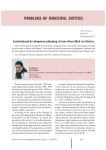
Institutional development planning of non-diversified territories
Статья научная
The article presents development trends of one-company towns, ways of the state support provided to such towns in Russia and abroad. It describes the results of monotown development, obtained with the state support, and presents the planning scheme of the institutional development of a company town.
Бесплатно
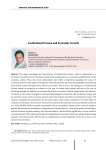
Institutional erosion and economic growth
Статья научная
The paper investigates the phenomenon of institutional erosion, which is understood as a decrease in the effectiveness of institutions due to the complication (or, conversely, simplification) of the economic system. Thus, the article substantiates and verifies a hypothesis regarding the impact of economic growth on the quality of institutions. We dwell upon the idea that the possibilities of preventing institutional erosion through timely reforms are limited. This is due to the emergence of institutional friction caused by resistance to reforms on the part of certain social groups and due to the rule of increasing damage. In addition, we consider the process of erosion of human capital under the influence of reforms in the context of cognitive and psychophysiological mechanisms. We put forward a basic and an extended version of the economic growth model that includes the effect of institutional erosion. We conduct computational experiments for the basic model, which made it possible to reveal the effect of economic overheating: a less intensive mode of investment in the long term turns out preferable compared to a more stressful mode of capital accumulation due to the gradual zeroing of the results of explosive growth. We describe the mechanism of degeneration of institutions (i.e., loss of the quality of institutions and the inversion of goals) caused by their internal dialectic. We discuss the significance of a new model of economic growth with institutional erosion for explaining the processes of both ascending and descending branches of social dynamics. We also give an interpretation of some important events of our time in the terms of the new theory.
Бесплатно
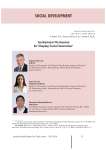
Institutional mechanism for shaping social innovation
Статья научная
Institutional environment creates conditions for shaping social innovation projects. In this case, current rules and standards can both stimulate and inhibit the development of social innovation in a particular territory. The goal of the present study is to develop an institutional mechanism for the formation of social innovation. It is done with the help of multiparameter systematization method, graphic modeling and other general scientific methods. Theoretical principles of the research presented in the paper are based on the institutional theory, public sector theory, innovations theory, life cycle theory and others. The authors systematize the institutions that influence the formation and development of socio-economic environment; they also point out a list of barriers in the sphere of social project management and put forward possible solutions that help mitigate the impact of inefficient institutional structures. The paper proposes an institutional mechanism for shaping social innovation; this mechanism shows possible reasons for inefficiency of social innovation projects and explains how the institutional environment and internal rules and regulations affect the feasibility of project implementation and its effectiveness...
Бесплатно
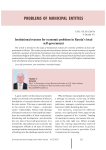
Institutional reasons for economic problems in Russia's local self-government
Статья научная
The article is devoted to the study of institutional reasons for economic problems of local self-government in Russia. The results proving the inconsistency between the actual incentives of regional authorities and goals of territorial development have been obtained upon analyzing the execution of consolidated budgets of RF subjects. The article defines the principal trends of formal state institutions’ modernization; the implementation of these directions will raise the interest of RF subjects’ administration in the development of local self-government’s economic base.
Бесплатно
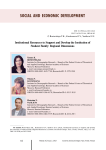
Статья научная
The article continues the set of demographic and sociological studies whose purpose is to analyze the value orientations and institutional resources that influence actors' marital and reproductive behavior. Theoretical basis of the study is represented by a wide range of works of Russian family scientists, demographers, specialists in the field of family sociology. We continue to develop the concept of a prosperous family within the framework of which we define the concept of “student family”, substantiate the tools for the research and conduct an empirical study. The main objective of the study is based on the data of a questionnaire survey of students. Moreover, it has to determine the relevance of the social policy implemented by the state and universities in relation to the development and support of the institute of student family (on the example of the Republic of Tyva). Data were obtained characterizing students' ideas about social policy measures in the interests of student families, institutional resources for the support and development of the institute of student family, and students' awareness of social support measures for young people studying in higher educational institutions. That allowed us to draw conclusions about what kind of assistance can be demanded by student families. We received the answer to the question whether students consider it necessary to support those who get married while studying at a higher educational institution. We systematize the data on the main areas of implementation of marital and reproductive behavior of Tyva students. It is revealed that social support measures will be in demand by student families. This should be taken into account when developing and implementing management decisions aimed at stabilizing the demographic situation in the region.
Бесплатно
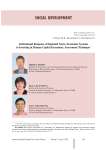
Статья научная
Modern theories view human capital as the main source of economic growth. Managing the concentration of human capital to form new growth centers, provided by the Concept of the strategy of Russia’s spatial development, requires the use of effective institutions. The authors’ method of studying the responses of socio-economic systems to changes in the institutional conditions of human capital increment helps determine the ranking of the impact of material and institutional factors applying the methodological tools of regression analysis using dummy variables. Moreover, the study based on the proposed method makes it possible to take into account the heterogeneous nature of the socio-economic space of Russian regions in the context of human-oriented development paradigm in assessing the effectiveness of institutions based on comparative analysis of standardized coefficients of institutional variables in the regression models of the managed characteristics of human capital by regional clusters...
Бесплатно
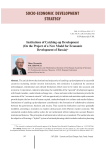
Статья научная
The article shows that institutional trajectories of catching-up development in successful countries including similar interim institutions; this similarity is explained by common technological, institutional and cultural limitations which need to be taken into account and overcome. Corporatism, indicative planning, the availability of the “general” development agency with broad mandate, undervalued exchange rate - these and some other mechanisms provide the countries of the “economic miracle” with an opportunity to initiate and maintain rapid economic growth despite the low level of human capital, underdeveloped civic culture and market failures. Institutions of catching-up development contributed to the formation of collaborative relations between the government, business and society. They eased the limitations and were gradually modified, providing a transition to modern democracies with efficient market economy. The conducted analysis helps outline a plan for an institutional reform taking into account Russia’s institutional features...
Бесплатно
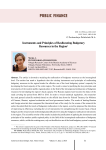
Instruments and principles of reallocating budgetary resources in the region
Статья научная
The article is devoted to studying the reallocation of budgetary resources at the intraregional level. The author has made a hypothesis that the existing instruments and principles of reallocating budgetary resources in the region hinder the effective use of the local budgetary system's capacity for developing the fiscal capacity of the entire region. The work is aimed at justifying the key principles and instruments of the modern public regional policy in the field of the intraregional reallocation of budgetary resources for developing the region's fiscal capacity. The Russian regions have become the object of the study covering the period from 2005 to 2018. In order to reveal statistical regularities, the researcher has used general scientific methods based on the official data from the Federal Treasury, the Ministry of Finance, Rosstat, regional authorities and local government bodies. The works of leading Russian and foreign scientists have composed the theoretical basis of the study. In the course of the research the author has identified the trends of budgetary reallocation in the region, as well as proposed the directions of improving its efficiency, including the set of instruments for strengthening the income basis of local budgets and the research and methodological justification for using the budgetary reallocation instruments in the region. The scientific novelty of the results includes the justification of applying the instruments and principles of the modern public regional policy in the field of the intraregional reallocation of budgetary resources, which, unlike the existing ones, rely on the effective use of the local budgetary system's capacity for developing the fiscal capacity of the entire region. The materials of the present article can be used in the educational sphere, as well as in the activities of public authorities and local government bodies.
Бесплатно
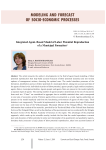
Integrated agent-based model of labor potential reproduction of a municipal formation
Статья научная
The article presents the author’s developments in the field of agent-based modeling of labor potential reproduction that help build scenario forecasts of labor potential dynamics and test various options of management actions, choosing the optimal ones. The model simulates processes of the formation, distribution and use of labor potential of a municipal district, taking into account activities of the agents of three levels: individuals (carriers of labor potential, agents-people), legal entities (employers, agents-firms), municipal authorities. Agents-people and agents-firms are present in the model explicitly as separate types of agents. The starting number of agents-people is determined at the rate of one person from each ten. “Firms” are considered in aggregate due to available statistical data: each corresponds to one type of economic activity. Thirteen agents-firms are presented as a total. Agents-authorities are present in the model implicitly and form the functioning environment of agents of other types...
Бесплатно
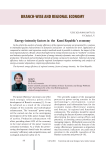
Integration approach to managing food industry in modern situation
Статья научная
In connection with the economic crisis the problem of creating an efficient algorithm for managing the food industry has recently become more urgent. In this paper we consider integration as an opportunity to improve efficiency and competitiveness of domestic enterprises. During the analysis of economic activity the given food industry, it has been concluded that under the current conditions the integration approach allows us to obtain competitive advantages, take leading positions in the market.
Бесплатно
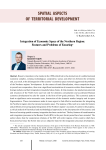
Integration of economic space of the northern region: features and problems of ensuring
Статья научная
Russia's transition to the market in the 1990s which led to the destruction of a unified national economic complex, existing technological, cooperative, social, and other ties between the territories and, as a result, to the disintegration of the country's economic space extremely aggravated the problems of the Northern regions' development. In the context of trade liberalization, when competition began to prevail over cooperation, there was a significant reorientation of economic entities from domestic to foreign markets and their integration into global value chains. In this situation, the production potential and resources of the North were used not only for domestic consumption and accelerated Russian economy development but also for export in the form of low-grade products. This economic pattern leads to significant socio-economic costs, destruction of the domestic market integrity and its space fragmentation. These circumstances make it more urgent to find effective mechanisms for integrating the Northern regions into the national economic space. The purpose of this work is to study the features and problems of ensuring spatial integration of the Northern region's economy. To achieve this purpose, a critical analysis of theoretical and methodological approaches to the interpretation of the essence and factors of ensuring spatial economy integration has been carried out. The key features of transformation and integration processes in the Russian North (RN) in the post-Soviet period have been revealed. The author shows that the cooperation relations of the RN with other regions of the country which have been preserved since the Soviet time are an objective basis for the integration processes development. However, their progress is hindered by negative demographic processes that limit the integration development in the region's labor market; a decrease in the space transport connectivity level due to the significant destruction of the system of intraregional aviation and inland water transport. The paper identifies transport connectivity of the main economic centers of the RN and “bottlenecks” in the region's transport infrastructure development. The authors substantiate conceptual basis for ensuring spatial integration of the Northern region's economy.
Бесплатно
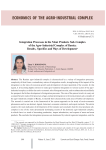
Статья научная
The Russian agro-industrial complex is characterized by a variety of integration processes, complexity of their forms, contradictory nature of integration results, strengthening of the impact of the integration on the rates of economic growth and development of export potential of the country. In this regard, it is becoming highly relevant to study agro-industrial integration in various sectors of the agro-industrial complex, to define the socio-economic role of integration units, and to substantiate scientifically the prospects for further development of integration processes. The aim of the present work is to carry out a comprehensive study of the processes of agro-industrial integration in the meat products sub-complex of the agro-industrial complex of Russia, to identify their characteristics and areas of further development. The research is carried out in the framework of the system approach to the study of socio-economic phenomena and we use abstract-logical, historical, economic-statistical, and expert methods...
Бесплатно
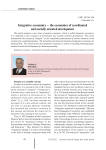
Integrative economics - the economics of coordinated and socially oriented development
Статья научная
The article proposes a new vision of modern economics, which is called integrative economics. It is regarded as the economics of coordinated and socially oriented development. The article substantiates the concept of “integrity” as the compromise participation of various structures in the creation of a coordinated product. The principles and structural elements of integrative economics are disclosed here. The article proves that integrative economics is aimed at ensuring promising future, oriented toward the development of a human personality.
Бесплатно
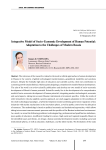
Статья научная
The relevance of the research is related to the need to rethink approaches to human development in Russia in the context of global technological transformations, geopolitical volatility and sanctions pressure. Despite the formally high rates of education and scientific activity, their real contribution to economic growth remains limited, which requires designing a comprehensive model of human development. The aim of the work is to review scientific publications and develop our own model of socio-economic development of Russia's human potential. Scientific novelty lies in the development of a comprehensive model of socio-economic development of human potential, integrating modern technological, economic and social aspects, taking into account Russian institutional environment specifics. Unlike the works of other researchers who also applied a systems approach, our study suggests adaptation to the conditions of the sixth technological paradigm, a hybrid development model combining government regulation of key industries with market mechanisms in the innovation sphere, as well as public control over the allocation of resources. The methodology is based on political economic and institutional approaches, which allows taking into account macroeconomic processes and the specifics of the Russian institutional environment. As a result, we reveal the following problems: technological lag, professional and qualification imbalance, poor quality of education, insufficient funding for science, high social and regional inequality. Based on the identified issues and threats, we design a human potential development model, including social and institutional spheres, as well as education, healthcare, and the labor market. The limitations of the study are related to the need for further elaboration on specific mechanisms for the implementation of the proposed model, including a system of indicators and economic policy measures. The research prospects include an in-depth analysis of regional specifics, as well as the adaptation of international experience to Russian conditions. Practical significance of the work lies in the possibility of using its findings to shape public policy in the field of education, science and social development.
Бесплатно
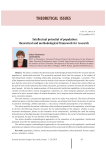
Intellectual potential of population: theoretical and methodological framework for research
Статья научная
The article considers the theoretical and methodological framework for the research into the population’s intellectual potential. The presented materials show that this category is the subject of interdisciplinary studies, including philosophy, psychology, sociology, pedagogics, economics. One of the important conclusions drawn from the analysis of the essence of intellectual potential is the conclu- sion that the actual level of intelligence is the result of its development. It means that certain efforts on the part of such social institutions like family, education, government, promote not only the formation of smart people, but also the implementation of their potential intellectual capabilities in the production, creation of cultural values, society management, education, etc. when using this approach, the intellect ceases to be just a research object of related disciplines, but it acquires social dimension and becomes a socio-economic category. The basic theories, concepts and approaches, used in its study, were analyzed...
Бесплатно
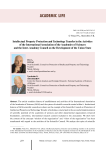
Статья научная
The article considers history of establishment and activities of the International Association of the Academies of Sciences (IAAS) and the system of scientific councils created within it. Institutional features of IAAS scientific councils are shown on the example of the Scientific Council on Protection of Intellectual Property and Technology Transfer, which plays a crucial part in the successful implementation of scientific potential of the academies of sciences and other departmental organizations (research foundations, universities, international research centers) included in the association. We show how the content of the concepts “mission of the organization” and “vision of the organization” has been transformed with regard to the activities of the Scientific Council. We analyze the topics of scientific reports, which are traditionally presented at meetings of the Scientific Council by its members and invited speakers (using the example of the reports made at the last meeting of the Scientific Council, which took place during the First Congress of the Scientific Councils of the IAAS in November 2021). We also consider integration initiatives of the Inter-Academy Council on the Development of the Union State (developing general conditions for intellectual property turnover within the framework of single innovation space, creating institutional structures oriented toward integration, etc.). We substantiate the conclusion about the paramount importance of intellectual property protection and technology transfer for further development of international scientific cooperation within the IAAS and the Inter-Academy Council on the Development of the Union State.
Бесплатно
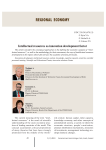
Intellectual resources as innovation development factor
Статья научная
The article considers the conceptual approaches to the defining the economic category of “intellectual resources”, as well as the methodology for their assessment, the ways of intellectual resources development in the regions which did not have the academic divisions previously.
Бесплатно
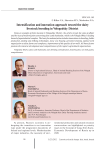
Intensification and innovation approach toward the dairy livestock breeding in Vologodsky district
Статья научная
Using an example of farms located in Vologodsky District, the article reveals the state of affairs and the ways of modernization concerning dairy cattle husbandry, which is the Vologda Oblast’s leading branch of agroindustrial complex. The basis for modernization includes innovations in breeding, fodder production, feeding and milking technologies, loose cow housing, personnel training, optimal work organization at dairy farms and complexes, improvement of the quality of raw milk. All these factors promote the intensive development and competitiveness of the region’s agricultural organizations.
Бесплатно

